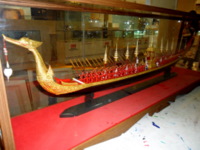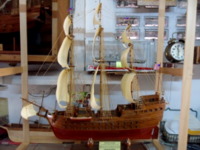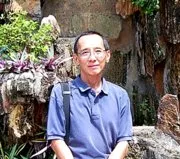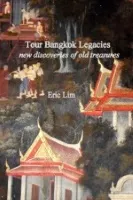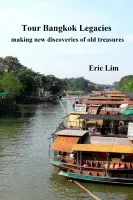The building is located in Dusit district, an area with royal palaces and military camps then and now. The old name of the soi where the museum is located was "Ongkharak" meaning officer in the Royal Guard or Aide-de-Camp.
The building is very well-preserved and hardly any renovation was required to start the museum.
- Home
- Bangkok Museums
- Museum of Floral Culture
Museum of Floral Culture
for an enchanting experience
By Eric Lim

The museum
The Museum of Floral Culture is the brain-child of floral artist Sakul Intakul who converted an old colonial building into a museum for floral art and designs that reflect Asian and Thai cultures.
This must be the newest museum in Bangkok. On the day of my visit, it was only three days old.
This floral museum was opened on 12 August 2012 on the occasion of HM the Queen’s 80th birthday and National Mothers’ Day.
There aren't many museums in the world dedicated solely to floral art. The only other one I can think of is the Chiba Floral Museum in Chiba City, Japan.
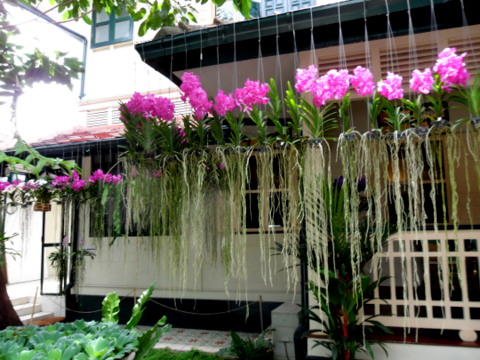
Orchids in the front porch
There’s more to floral design than just flower arrangements. Flowers can be taken apart and reassembled into completely different shapes and designs; it can be strung together as garlands, pendants or made into domes.
Designs can be as simple as a single flower, elaborate displays at banquets or festoons gracing the façade of huge buildings.
Let's find out more about this old house, the man who made it possible and take a guided tour of the Museum of Floral Culture and its surroundings.
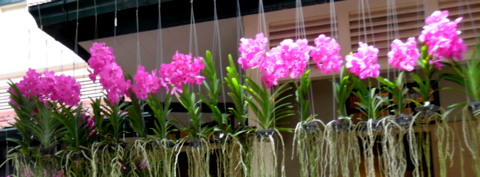
Contents
- About the house
- About Sakul Intakul
- Dusit Gallery
- World of Floral Culture
- Temple of Nature/Temple of People
- Heritage of Thai Floral Culture
- Banana Leaf Room
- Pen, Pencil & Possibility
- Dok Mai Thai Salon du The – the tea salon
- Garden
- Future Plans
- Map to the Museum of Floral Culture/opening times/contact
- My thanks
About the house
The Museum of Floral Culture is housed in an old massive two-storey building made of golden teak. It was built in 1920 and was the home of an officer in the Royal Guard in the reign of King Rama VI.
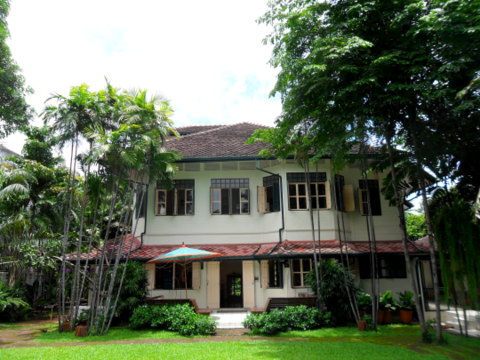
Rear view of house
About Sakul Intakul
Sakul Intakul, the man who started this museum, is called a floral artist who creates and installs floral designs. Surprisingly he started his working life as an electronic engineer in the sales and marketing department in a Japanese company dealing in integrated circuits!
Later he took up a course in classical flower arrangements at a Japanese school in Bangkok and completed the elementary, advanced and teaching stages.
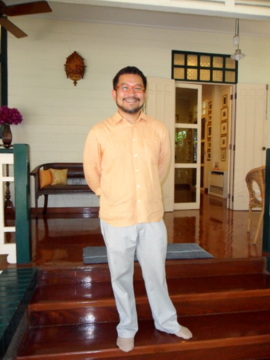
From then on it was the start of a new adventure that took him to several places in the world to study the local floral cultures.
Sakul Intakul’s artistic achievements include floral arrangements at
- The royal banquet for the Diamond Jubilee of HM the King in June 2006
- Farewell banquet for the Heads of State at the APEC Conference in Bangkok in October 2003
- The Bvlgari Hotel in Bali, Indonesia.
- International Film Festival in Rome in October 2007
Sakul was also awarded UNESCO Seal of Excellence for Handicraft Products S E Asia 2004.
Establishing the Museum of Floral Culture is the realization of a dream to establish a centre for Thai floral culture and share his floral art with others. Let us join Sakul Intakul as he takes us on a guided tour of this unique museum.
Please note that no photographs are allowed inside the museum. Indoor images are taken from a CD presented by Sakul Intakul to the media.
Photographs are allowed in The Asian Tea Salon and the garden.
Table of contents
Dusit Gallery
The first room we entered was the Dusit Gallery, the walls of which hung photos of royalty in the reign of King Rama V, courtesy of the National Archives.
Sakul Intakul points to a photo of a sister of King Rama V whom he considers Thailand’s first floral artist. The Fifth Reign saw a revival of Thai floral culture and the old photos depict Thai and foreign floral arrangements the early 20th century including a floral mobile procession in old Ford cars.
Table of contents
World of Floral Culture
The second room in the Museum of Floral Culture features floral cultures in Asia; Bali, India, Japan, Khmer, Laos, Tibet.
A long three-metre scroll is displayed in a showcase in the centre of the room. It’s written in Japanese, from top down and right to left.
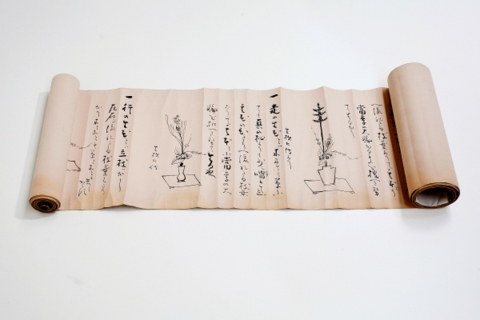
Old Japanese scroll dated 1756
Sakul bought this scroll from an antique dealer in Tokyo. It’s entitled "The Secret Book of Shoka Floral Arrangement of Ikenobo*".
*Ikenobo is the oldest school in ikebana, Japanese flower arrangement as a Buddhist floral offering. It was founded in Kyoto by Ikenobo Senno in 1542.
These are floral displays used in festivals and ceremonies of the various societies rich in floral culture; the Japanese chabana or tea ceremony, Balinese flowers, Indian garlands, Tibetan religious offerings, Khmer ceremonial floral headgear.
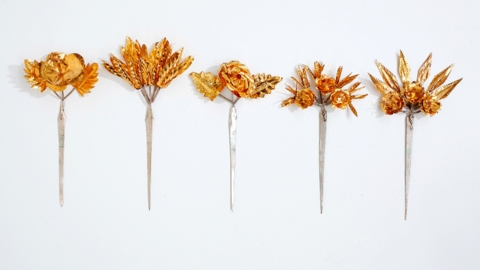
Floral hair pins - Bali
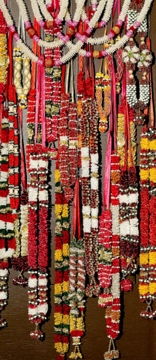
Floral garlands – India
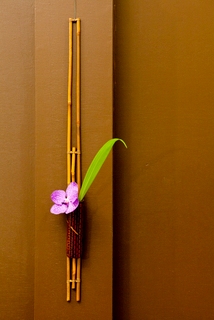
Simplicity - orchid and leaf in bamboo vase – Japan
Here we see a different aspect of floral art in the form of floral posters.
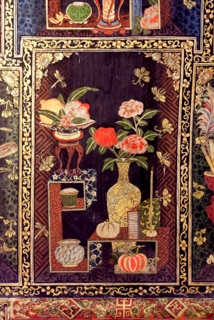
Murals in Wat Ratchaorot - Chinese
vase and flowers
Sakul intends to extend the scope of displays in this room to include African and European floral cultures.
Table of contents
Temple of Nature/Temple of People
The exhibits in this room were inspired by the people from a village, Ban Saeng Pha in Loei in north-eastern Thailand. This community has been living near a large forest reserve for generations and has depended on the mountain streams for their water.
In 1983 the government granted a company a logging concession in this forest reserve. The villagers protested vehemently but their protests fell on deaf years.
As a last resort, they came to Bangkok and marched to Government House where they offered to surrender all their Thai identity cards, Thai citizenship and return to Laos if the government proceeded with the logging project.
The government backed down and cancelled the concession. That forest reserve is today the Phu Suan Sai National Park, Loei.
The exhibition room, Temple of Nature/Temple of the People is dedicated to the villagers of Ban Saeng Pha for their efforts to preserve nature and in the process preserve their traditional way of life.
In the words of Sakul Intakul, "I want to pay my respects to the strength of this community that helped save a forest. Floral culture can't be born without a forest."
As you enter the room, you will be faced with a huge mural of forest on one wall with trees extending right up to the ceiling.
Pictures of the people of Ban Saeng Pha are displayed on the opposite wall. The people here celebrate Songkran differently with a ceremony called ""ton dork mai". They carry to the temple wooden structures 8 – 9 m high decorated with flowers.
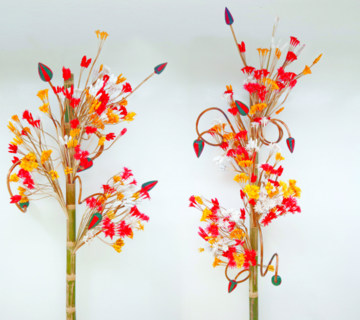
Floral offerings at Wat Sri Pho Chai, Loei
At the end of the room is a reproduction of the shrine at Wat Sri Pho Chai the community temple in Loei. Craftsmen from the community were commissioned to produce the shrine for the Museum of Floral Culture.
Sakul intends to invite representatives from the village to the museum for the official opening of the museum.
Table of contents
Heritage of Thai Floral Culture
Next we entered what appeared to be a dining room with a long dining table set for a meal. Sakul drew my attention to a sideboard with several glass cases of flowers.
This display he explained is the "architecture of floral design", the "heart of Thai floral culture". Let's find out why.
The first display was a purple orchid flower; another similar flower had its petals separated. These petals are then sewn, pinned or tied depending on the floral design.
Several of these reconstructed petals are assembled to form new shapes or patterns. Traditionally, these petals are attached to wooden slivers and pinned to a molded clay core to form a dome. Or they could be sewn together to make a pendant or strung up for a garland.
Sakul has contemporary and traditional designs where the petals are pinned to frames of different forms or made into floral posters. Here are some examples.
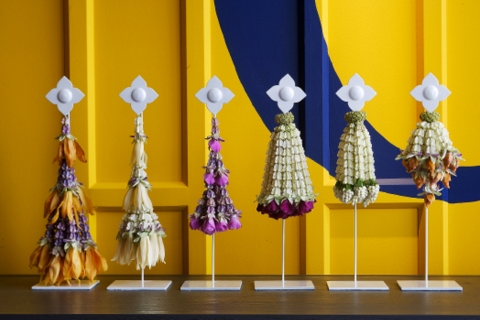
An assortment of garlands
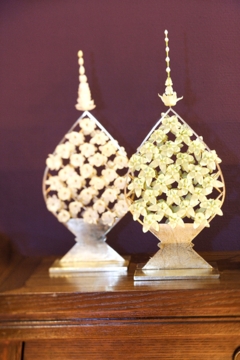
An arrangement of crown flowers and jasmine
Another example of a floral poster is a reproduction of the mural on the door to the viharn in Wat Sommanat.
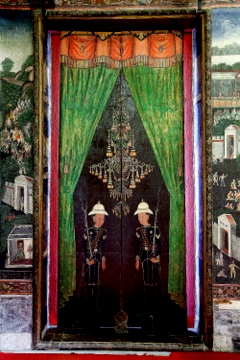
Floral version of a temple mural
Table of contents
Banana Leaf Room
The Banana Leaf Room in the Museum of Floral Culture features some local customs. The first is the "bai sri" or auspicious rice offering which is done in a wooden structure made of multiple layers of trays (ton bai sri). This is an Issarn custom to welcome visitors.
The local belief is that when someone travels, his spirit leaves the body.
This offering welcomes the guest and brings his spirit back to him.
The number of trays has nine levels when presented to welcome a king and seven levels for a queen.
There’s a dowry set on the coffee table consisting of three trays made from folded banana leaves. In Thai custom as in Chinese, the bridegroom presents the dowry to the bride’s parents.
The first tray has a thick stack of bank notes, another is a betel leaf bowl and the third has floral bouquet consisting of flowers representing love, prosperity and mutual respect in a relationship.
Table of contents
Pen, Pencil & Possibilities
Our tour of the Museum of Floral Culture takes us upstairs in this spacious colonial bungalow. In Pen, Pencil & Possibilities, Sakul illustrates how his ideas and inspirations are first sketched on paper then translated in floral designs.
Both the sketches and the final floral designs are framed and displayed on the walls.
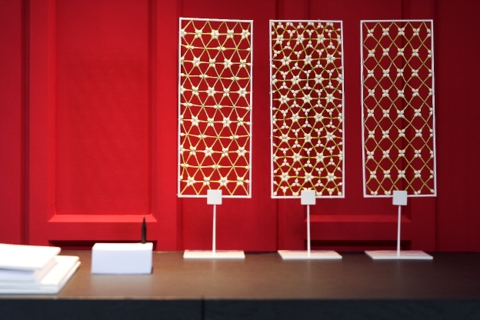
Gardenias woven into nets
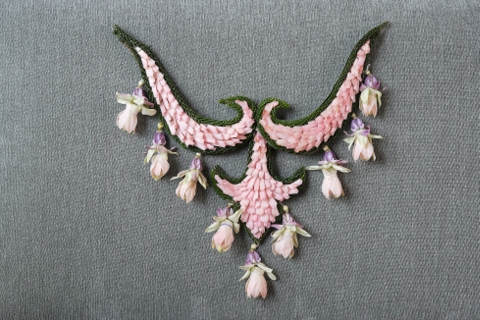
Orchid petals sewn into a festoon with nine orchids attached
Pride of place among the exhibits is a photo taken in June 2006 of the main table in the royal banquet hosted by HM the King with Sultan Hassanal Bolkiah of Brunei seated to the right.
The floral design on that table cloth was done by Sakul Intakul. So were the floral displays for that banquet.
Sakul’s other work at the International Film Festival in Rome in 2007 as well as his UNESCO award are also on display.
Table of contents
Dok Mai Thai Salon du The – the tea salon
After the tour of the exhibits, proceed to the terrace and relax in Dok Mai Thai Salon du The – the tea salon to savour a variety of Asian teas and Asian deserts. The tea salon is beautifully decorated and you are free to take photographs here.
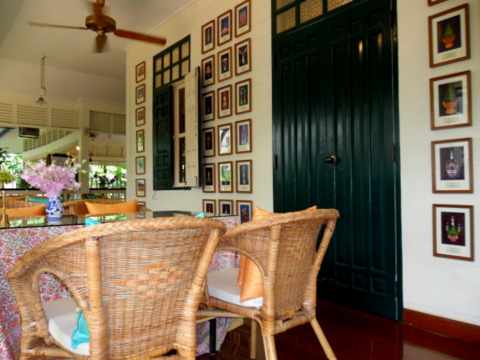
Dok Mai Thai Salon du The
Of particular interest are the photos of old floral designs hanging from the walls and the variety of charming fresh orchids in vases on the tables.
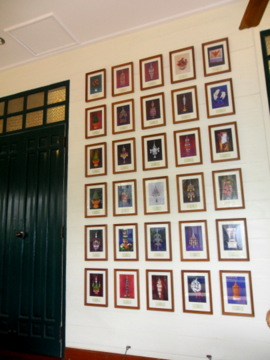
Enjoy your refreshments to the soothing sounds of piped music from the garden featuring Chinese, Indian, Japanese and Thai traditional tunes.
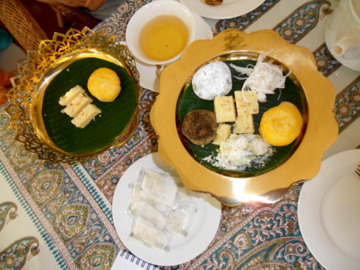
Mouth-watering Asian deserts
Table of contents
Garden
Finally end your tour of the Museum of Floral Culture with a stroll through the spacious garden that’s 1,800 sq metres filled with orchids and the various plants used in Sakul’s floral designs. He tries to maintain 20% of his displays with fresh flowers.
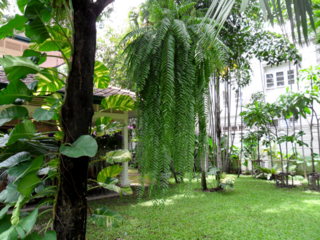
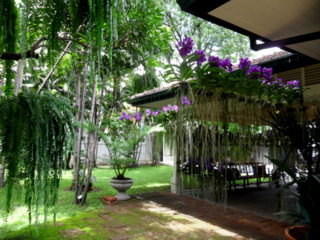
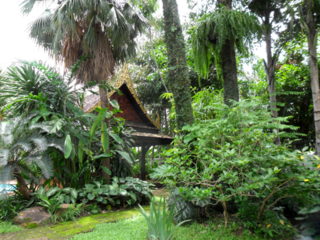
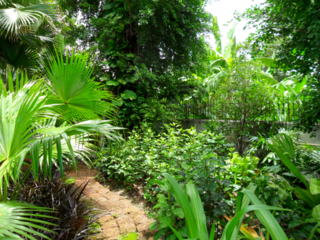
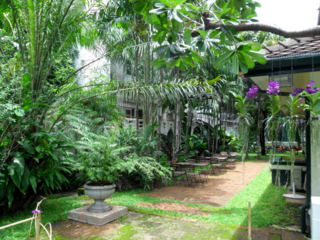
The garden to the side of the house is an extension of the tea salon if you prefer to have your tea outdoors. A stone slab path takes you around the garden and to the rear where you will find a sala and a swimming pool.
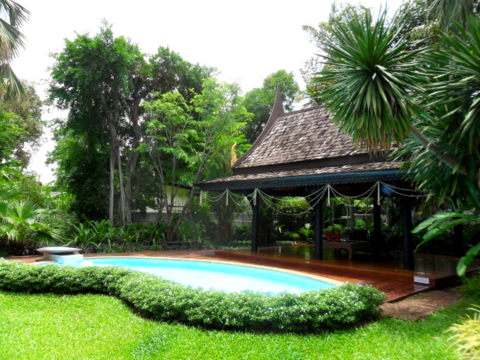
Sala & swimming pool
Future Plans
Future plans for the Museum of Floral Culture include:
- Floral designs from Africa and Europe in the room on World of Floral Culture
- Modern Floral Designs in a room upstairs
- A souvenir shop in the garden where books by Sakul Intakul will be available
Map to the Museum of Floral Culture
View The Museum of Floral Culture in a larger map
How to get there
If you are driving, go along Sam Sen Road pass the National Library. Keep going till you pass the Bang Krabue intersection. Soi Sam Sen 28 is the first turning on the right.
Air-conditioned buses service 16 from Siam Square and service 50 from Mah Boon Khrong pass Sam Sen Road. Alight at the first bus stop after the Bang Krabue intersection.
Opening times
The Museum of Floral Culture is open every day except Mondays from 1000 – 1800 hours.
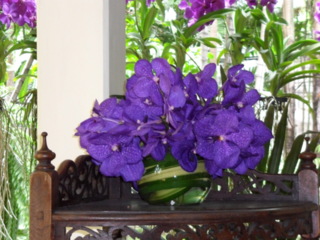
Admission fee is 150 baht. Dok Mai Thai Salon du The – the tea salon and garden can be rented for private functions for less than 100 people.
Guided tours are conducted in English at 1100 hours and Thai at 1400 hours and 1600 hours.
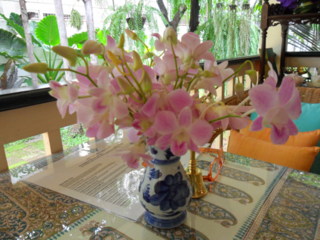
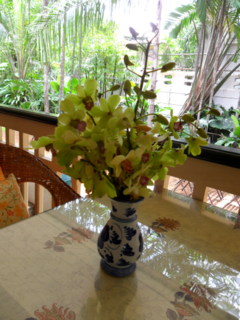
Contact information
The Museum of Floral Culture
315 Samsen Soi 28 (Soi Ongkharak)
Yaek (sub-soi) Ongkharak 13
Samsen Road
Dusit
Bangkok 10300
Thailand
Tel: + 662 669 3633 – 4
My thanks
I like express my sincere thanks to Sakul Intakul for his warm hospitality during my visit to the Museum of Floral Culture and the information provided by him to make this article possible.
His stories behind the various exhibits are very engaging and help our understanding of the philosophy behind these designs and exhibits.
I am grateful for the CD which contains photos of the exhibits indoors which I have used in this article with the courtesy of Sakul Intakul.
Photographs of the Asian Tea Salon and garden were taken with his kind permission.
Lastly my thanks to Sakul for the phrase "an enchanting experience" in the title of this article. He mentioned this as we spoke over tea. I can’t think of a more appropriate expression to describe the Museum of Floral Culture.
Table of contents
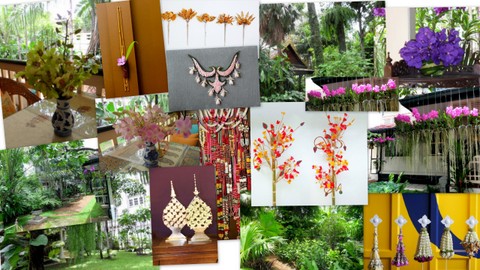
Stay updated with what's new at Tour Bangkok Legacies. Subscribe to the RSS feed at the top of the navigation bar on the left.
To return to Bangkok Museums and for other forms of Traditional Thai art.
Other attractions nearby
My Journey through Thailand Part I The First Steps
This is my second e-book and the first in the series of travel journals on my trips to explore the various provinces in Thailand. This edition, which covers my travels from late 2009 to mid-2013, will guide you to historical sites, cultural monuments and exquisite Thai handicraft, across a vast spectrum of cultural and ethnic diversity.
You can have a virtual tour with this e-guide book or take the first steps yourself in this journey through Thailand.
My Kindle e-book
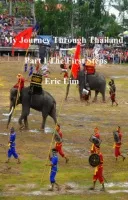
Search Tour Bangkok Legacies with DuckDuckGo
My Journey through Thailand
Part I The First Steps
My Kindle edition

My Smashwords edition

